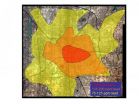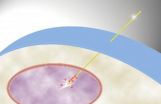Red light regulates nectar secretion
Nectar production in lima beans depends on light quality
2010-09-28
(Press-News.org) Flowering plants produce nectar to attract insect pollinators. Some plant species, such as Lima bean, also secrete nectar from so-called extrafloral nectaries to attract ants which in turn fend off herbivores. Scientists of the Max Planck Institute in Jena, Germany, have discovered that the production of extrafloral nectar is light dependent. They have shown that the plants are able not only to distinguish between day and night, but also to adapt their nectar secretion to current light conditions by using a special photoreceptor, the phytochrome. Phytochrome probably influences the regulation of a special enzyme that binds the plant hormone jasmonic acid (JA) to the amino acid isoleucine (Ile). The emerging JA-Ile molecule affects the secretion of extrafloral nectar in such a way that the plant's defense against herbivores is most effective whenever herbivory is most likely – or, more precisely, during the day. (PNAS Early Edition, DOI: 10.1073/pnas.1009007107)
Plants have to continuously defend themselves against herbivores to survive and reproduce. They do this directly by producing toxic substances, such as nicotine, or indirectly, by calling their enemies' enemies for help. An example of an indirect defense is the release of volatile substances that attract predatory insects or parasitoids and guide them to their prey; for example, predatory wasps or bugs are led to a caterpillar that is feeding on a plant.
Another indirect defense is the secretion of extrafloral nectar from special leaf organs. In this way Lima beans attract ants that not only enjoy the sweet nectar but also defend the plant against herbivores. Scientists in the Department of Bioorganic Chemistry study this "sweet" defense mechanism. Radhika Venkatesan, a PhD student from India, completed a series of experiments on this topic and tested whether nectar secretion in Lima beans is light dependent. "After all, nectar consists mainly of sugars, and sugars are primary products in the process of photosynthesis – which depends on light," notes the scientist. In the course of her studies, which were published in the Early Edition of the "Proceedings of the National Academy of Sciences USA" last week, she came across an old acquaintance in plant research – the so-called phytochrome. Plants contain phytochromes as photoreceptors in their leaves, which is the reason why phytochromes are sometimes called "the eye of the plant."
"Not the light intensity, but light quality or composition plays a decisive role in regulating nectar production in Lima bean," says Wilhelm Boland, director of the Max Planck Institute. As he explains, the phytochrome in the plant absorbs red light that enables the plant to distinguish the diurnal and seasonal variation of sunlight quality. Radhika Venkatesan's experiments are the first to demonstrate that plants also use the phytochrome system to set up their lines of defense effectively and economically.
The hormone jasmonic acid is known as an important signal that plants produce after wounding by herbivores. It also plays a central role in regulating nectar secretion. The scientists have discovered that phytochrome-mediated light regulation has a significant impact on the signaling effect of jasmonic acid: Free jasmonic acid inhibits nectar secretion in the dark but stimulates its production in the light. Radhika Venkatesan found the key to this light-regulated behavior in a reaction that binds jasmonic acid to the amino acid isoleucine. The emerging conjugate JA-Ile is a signal molecule already known from other studies. For the first time, it has been identified as the actual elicitor of nectar secretion. Additional experiments have confirmed that nectar production doesn't increase if binding of JA and isoleucine is prohibited by an inhibitor. If plants are wounded in the dark to stimulate JA production, JA-Ile is produced only in those leaves that were previously exposed to red light. [JWK, AO]
INFORMATION:
Original Publication:
Venkatesan Radhika, Christian Kost, Axel Mithöfer, Wilhelm Boland (2010). Regulation of extrafloral nectar secretion by jasmonates in lima bean is light dependent. Proceedings of the National Academy of Sciences USA, Early Edition, 20. September 2010, DOI: 10.1073/pnas.1009007107
Further Information:
Prof. Dr. Wilhelm Boland, Max Planck Institute for Chemical Ecology, Hans-Knöll-Straße 8, 07745 Jena, Germany. Tel.: +49 (0)3641- 57 1200; boland@ice.mpg.de
Picture Requests:
Angela Overmeyer, Max Planck Institute for Chemical Ecology, Hans-Knöll-Straße 8, 07745 Jena, Germany. Tel.: +49 (0)3641- 57 2110; overmeyer@ice.mpg.de
ELSE PRESS RELEASES FROM THIS DATE:
2010-09-28
ROCHESTER, Minn. -- In one of the first studies to focus exclusively on the outcomes after treatment for patients with high-risk prostate cancer,(http://www.mayoclinic.org/prostate-cancer/) researchers have found that surgery provides high survival rates. Collaborating researchers at Mayo Clinic and Fox Chase Cancer Center (http://www.fccc.edu/) in Philadelphia discovered that patients with the most aggressive forms of prostate cancer who had radical prostatectomy procedures had a 10-year cancer-specific survival rate of 92 percent and an overall survival rate of 77 percent.
The ...
2010-09-28
While the U.S. has made great progress in the prevention and treatment of tuberculosis, the nation has become more susceptible to potential epidemics of multidrug-resistant tuberculosis (MDR-TB), according a study led by Johns Hopkins researchers. Computer simulations show that as TB prevalence falls, the risk for more extensive MDR-TB increases. In addition, the simulation also showed that higher detection of TB cases without proper treatment of cases also increased risk. The study findings are published in the September 22 edition of the journal PLoS ONE. An interactive ...
2010-09-28
Newport Beach, CA – September 27, 2010 – Hoag Memorial Hospital Presbyterian recently announced encouraging clinical study results for patient-specific vaccine therapy to treat metastatic melanoma. The study is ongoing, but the report concludes that patient-specific vaccines can sometimes induce durable complete regression of progressing soft-tissue melanoma metastases, as demonstrated in one particular patient who participated in the trial.
The study report, entitled: "Durable Complete Response of Refractory, Progressing, Metastatic Melanoma after Treatment with a ...
2010-09-28
About ten years ago, the discovery of microRNAs ― tiny cellular molecules that regulate our genetic code ― unlocked a world of scientific possibilities, including a deeper understanding of human disease. One new analytical technology is "deep sequencing," which gives scientists the ability to discover invaluable information about human diseases at a genetic level. Now, Tel Aviv University researchers have developed the cutting-edge technology to better analyze these results.
The software, called miRNAkey, was developed by Roy Ronen as part of a team of researchers ...
2010-09-28
Elevated concentrations of nitrogen and phosphorus, nutrients that can negatively impact aquatic ecosystems and human health, have remained the same or increased in many streams and aquifers across the Nation since the early 1990's, according to a new national study by the U.S. Geological Survey.
"This USGS report provides the most comprehensive national-scale assessment to date of nitrogen and phosphorus in our streams and groundwater," said Marcia McNutt, USGS Director. "For years we have known that these same nutrients in high concentrations have resulted in 'dead ...
2010-09-28
URBANA – Tile drainage in the Mississippi Basin is one of the great advances of the 19th and 20th centuries, allowing highly productive agriculture in what was once land too wet to farm. In fact, installation of new tile systems continues every year, because it leads to increased crop yields. But a recent study shows that the most heavily tile-drained areas of North America are also the largest contributing source of nitrate to the Gulf of Mexico, leading to seasonal hypoxia. In the summer of 2010 this dead zone in the Gulf spanned over 7,000 square miles.
Scientists ...
2010-09-28
INDIANAPOLIS – Not since victory gardens helped World War II era Americans on the home front survive food shortages have urban gardens been as necessary and popular as they are today. With more food production in cities, the safety of the produce grown there becomes increasingly important.
As city dwellers across the country are harvesting fruits and vegetables for family consumption and planning ahead for the next planting season, geochemist Gabriel Filippelli, Ph.D., professor of earth sciences at the School of Science at Indiana University-Purdue University Indianapolis, ...
2010-09-28
CHAMPAIGN, Ill. — Getting an inside look at the center of a cell can be as easy as a needle prick, thanks to University of Illinois researchers who have developed a tiny needle to deliver a shot right to a cell's nucleus.
Understanding the processes inside the nucleus of a cell, which houses DNA and is the site for transcribing genes, could lead to greater comprehension of genetics and the factors that regulate expression. Scientists have used proteins or dyes to track activity in the nucleus, but those can be large and tend to be sensitive to light, making them hard ...
2010-09-28
Electric cars hold greater promise for reducing emissions and lowering U.S. oil imports than a national renewable portfolio standard, according to research conducted by Rice University's Baker Institute for Public Policy.
This assessment is among several contained in a new major policy study the Baker Institute Energy Forum will release at a Sept. 27-28 conference titled "Energy Market Consequences of an Emerging U.S. Carbon Management Policy." The study comprises several academic working papers on a variety of topics, such as carbon pricing, the wind industry, global ...
2010-09-28
Unlike nerves of the spinal cord, the peripheral nerves that connect our limbs and organs to the central nervous system have an astonishing ability to regenerate themselves after injury. Now, a new report in the October 1st issue of Cell, a Cell Press publication, offers new insight into how that healing process works.
"We know a lot about how various cell types differentiate during development, but after a serious injury like an amputation, nerves must re-grow," said Allison Lloyd of University College London. "They need a new mechanism to do that because the developmental ...
LAST 30 PRESS RELEASES:
[Press-News.org] Red light regulates nectar secretion
Nectar production in lima beans depends on light quality


